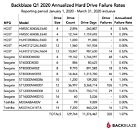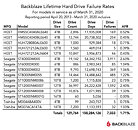Raevenlord
News Editor
- Joined
- Aug 12, 2016
- Messages
- 3,755 (1.15/day)
- Location
- Portugal
| System Name | The Ryzening |
|---|---|
| Processor | AMD Ryzen 9 5900X |
| Motherboard | MSI X570 MAG TOMAHAWK |
| Cooling | Lian Li Galahad 360mm AIO |
| Memory | 32 GB G.Skill Trident Z F4-3733 (4x 8 GB) |
| Video Card(s) | Gigabyte RTX 3070 Ti |
| Storage | Boot: Transcend MTE220S 2TB, Kintson A2000 1TB, Seagate Firewolf Pro 14 TB |
| Display(s) | Acer Nitro VG270UP (1440p 144 Hz IPS) |
| Case | Lian Li O11DX Dynamic White |
| Audio Device(s) | iFi Audio Zen DAC |
| Power Supply | Seasonic Focus+ 750 W |
| Mouse | Cooler Master Masterkeys Lite L |
| Keyboard | Cooler Master Masterkeys Lite L |
| Software | Windows 10 x64 |
As of March 31, 2020, Backblaze had 132,339 spinning hard drives in our cloud storage ecosystem spread across four data centers. Of that number, there were 2,380 boot drives and 129,959 data drives. This review looks at the Q1 2020 and lifetime hard drive failure rates of the data drive models currently in operation in our data centers and provides a handful of insights and observations along the way. In addition, near the end of the post, we review a few 2019 predictions we posed a year ago. As always, we look forward to your comments.
Hard Drive Failure Stats for Q1 2020
At the end of Q1 2020, Backblaze was using 129,959 hard drives to store customer data. For our evaluation we remove from consideration those drives that were used for testing purposes and those drive models for which we did not have at least 60 drives (see why below). This leaves us with 129,764 hard drives. The table below covers what happened in Q1 2020.

Notes and Observations
The Annualized Failure Rate (AFR) for Q1 2020 was 1.07%. That is the lowest AFR for any quarter since we started keeping track in 2013. In addition, the Q1 2020 AFR is significantly lower than the Q1 2019 AFR which was 1.56%.
During this quarter 4 (four) drive models, from 3 (three) manufacturers, had 0 (zero) drive failures. None of the Toshiba 4 TB and Seagate 16 TB drives failed in Q1, but both drives had less than 10,000 drive days during the quarter. As a consequence, the AFR can range widely from a small change in drive failures. For example, if just one Seagate 16 TB drive had failed, the AFR would be 7.25% for the quarter. Similarly, the Toshiba 4 TB drive AFR would be 4.05% with just one failure in the quarter.
On the contrary, both of the HGST drives with 0 (zero) failures in the quarter have a reasonable number of drive days, so the AFR is less volatile. If the 8 TB model had 1 (one) failure in the quarter, the AFR would only be 0.40% and the 12 TB model would have an AFR of just 0.26% with 1 (one) failure for the quarter. In both cases, the 0% AFR for the quarter is impressive.
There were 195 drives (129,959 minus 129,764) that were not included in the list above because they were used as testing drives or we did not have at least 60 drives of a given model. For example, we have: 20 Toshiba 16 TB drives (model: MG08ACA16TA), 20 HGST 10 TB drives (model: HUH721010ALE600), and 20 Toshiba 8 TB drives (model: HDWF180). When we report quarterly, yearly, or lifetime drive statistics, those models with less than 60 drives are not included in the calculations or graphs. We use 60 drives as a minimum as there are 60 drives in all newly deployed Storage Pods.
Lifetime Hard Drive Stats
The table below shows the lifetime failure rates for the hard drive models we had in service as of March 31, 2020. The reporting period is from April 2013 through December 31, 2019. All of the drives listed were installed during this timeframe.

View at TechPowerUp Main Site
Hard Drive Failure Stats for Q1 2020
At the end of Q1 2020, Backblaze was using 129,959 hard drives to store customer data. For our evaluation we remove from consideration those drives that were used for testing purposes and those drive models for which we did not have at least 60 drives (see why below). This leaves us with 129,764 hard drives. The table below covers what happened in Q1 2020.

Notes and Observations
The Annualized Failure Rate (AFR) for Q1 2020 was 1.07%. That is the lowest AFR for any quarter since we started keeping track in 2013. In addition, the Q1 2020 AFR is significantly lower than the Q1 2019 AFR which was 1.56%.
During this quarter 4 (four) drive models, from 3 (three) manufacturers, had 0 (zero) drive failures. None of the Toshiba 4 TB and Seagate 16 TB drives failed in Q1, but both drives had less than 10,000 drive days during the quarter. As a consequence, the AFR can range widely from a small change in drive failures. For example, if just one Seagate 16 TB drive had failed, the AFR would be 7.25% for the quarter. Similarly, the Toshiba 4 TB drive AFR would be 4.05% with just one failure in the quarter.
On the contrary, both of the HGST drives with 0 (zero) failures in the quarter have a reasonable number of drive days, so the AFR is less volatile. If the 8 TB model had 1 (one) failure in the quarter, the AFR would only be 0.40% and the 12 TB model would have an AFR of just 0.26% with 1 (one) failure for the quarter. In both cases, the 0% AFR for the quarter is impressive.
There were 195 drives (129,959 minus 129,764) that were not included in the list above because they were used as testing drives or we did not have at least 60 drives of a given model. For example, we have: 20 Toshiba 16 TB drives (model: MG08ACA16TA), 20 HGST 10 TB drives (model: HUH721010ALE600), and 20 Toshiba 8 TB drives (model: HDWF180). When we report quarterly, yearly, or lifetime drive statistics, those models with less than 60 drives are not included in the calculations or graphs. We use 60 drives as a minimum as there are 60 drives in all newly deployed Storage Pods.
Lifetime Hard Drive Stats
The table below shows the lifetime failure rates for the hard drive models we had in service as of March 31, 2020. The reporting period is from April 2013 through December 31, 2019. All of the drives listed were installed during this timeframe.

View at TechPowerUp Main Site






 The title just made me laugh! like Dir!! who didnt see that one coming
The title just made me laugh! like Dir!! who didnt see that one coming 
